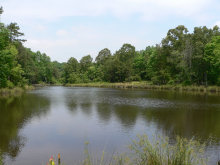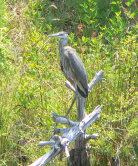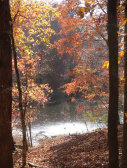

Wildlife Conservation

Points of Interest
Foxbrier has eight ponds-- the largest being some nine acres in extent. The most recent pond, completed in 2007, is a shallow waterfowl habitat along Little River.
With its large stands of old hardwood trees and numerous long hedgerows, Foxbrier is attractive to a wide variety of wildlife. The farm lies in the heart of Block 5 of the S. C. Breeding Bird Atlas, noted for having the highest concentration of breeding birds, particularly neo-tropicals, in the upstate.
Interesting bird sightings at Foxbrier include Bald Eagle, Osprey, Louisana Water Thrush, Henslow's Sparrow, Grasshopper Sparrow, Double-crested Commorant, and immature White Ibis.
By placing a conservation easement on most of Foxbrier in 2006, we affirmed that this land would be kept in a rural state for all time. This agreement with Upper Savannah Land Trust insures, among other things, that much of Foxbrier will retain its wild character. There will always be a place for the Great Blue Herons on our ponds and thickets for Cottontail Rabbits, woodlands for Turkeys and varied habitat for Whitetail Deer and Bobcats.
Water plays a major role in wildlife management and resource conservation here. Horsetail Creek, Mills Creek, Ratlin' Flint Branch, and two unnamed streams flow through Foxbrier into Little River. The river itself begins in a series of springs on the west side of Foxbrier and on lands just beyond. With good management practices, we are keeping this important watershed in a pristine condition.
All of Foxbrier is considered a wildlife sanctuary. Additionally, the forests along the head- waters of Little River are reserved solely as a wildlife refuge.





